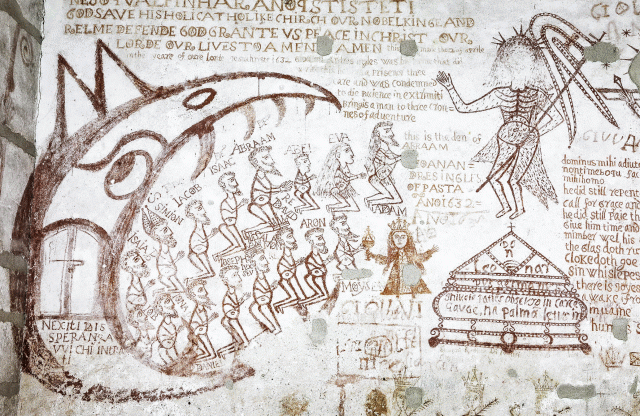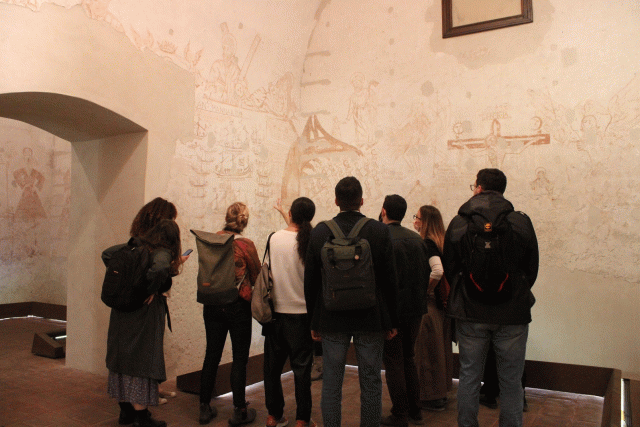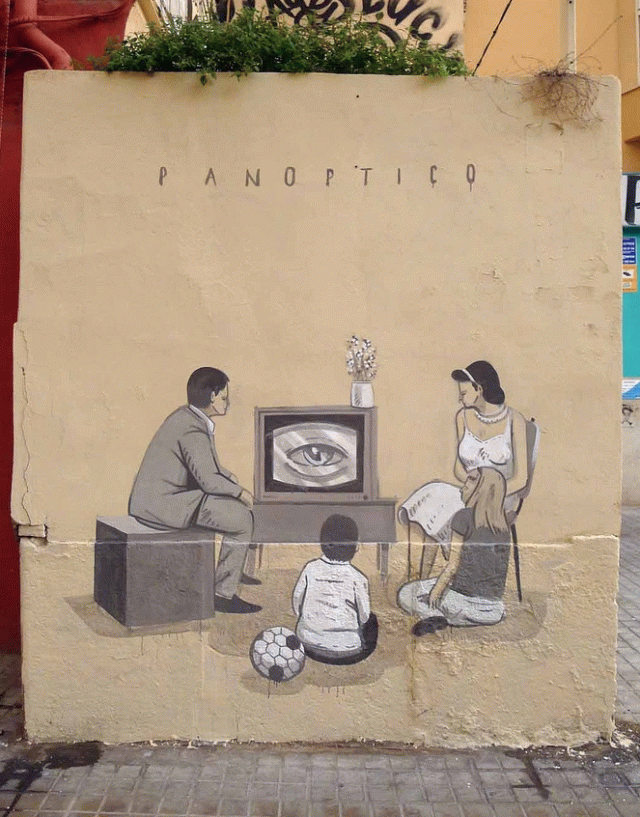Workshop
GAP Project – Graffiti Art in Prison
Modes of Expression and Resistance in Prison Environments: Graffiti in their Devotional and Political Dimensions (Hybrid)
Sixth Intensive Study Week organized by Christine Kleiter (Kunsthistorisches Institut in Florenz – Max-Planck-Institut) and Federica Testa (Kunsthistorisches Institut in Florenz – Max-Planck-Institut)
Biblical scenes, figures of saints and martyrs, and depictions of Christ and the Virgin Mary are among the motifs most frequently represented on the walls of the Inquisition prisons as well as other places of reclusion and detention. In this workshop, we will explore the votive dimension of graffiti and the role of muralism as a form of political activism, social criticism, and vehicle for protest and resistance. Locally, we will also consider the historical legacy of sgraffito on Florentine palatial façades and its relationship to contemporary graffiti. We will start with the example of Florence’s Le Murate, a former female monastery turned prison, and then move to prison islands as extreme examples of punitive isolation. Other Italian case studies, such as graffiti in the Inquisition prison in Narni, Oreste Nannetti’s graffiti in Volterra former psychiatric hospital, and William Kentridge’s ‘political’ frieze in Rome, offer the opportunity to discuss relationships between punishment and expiation, faith and devotion, art and dictatorship, freedom and censorship, and concealment and visibility. Collectively, we will reflect on the (im)permanence of graffiti and its intrinsic fragility as a medium entrusted with the precarious task of preserving memory.
PROGRAM
This event will take place in a hybrid format. Speakers marked with an asterisk (*) will take part from remote. To participate online please register in advance via Zoom: https://zoom.us/meeting/register/tJAvcOytrjorGNRMSQKhsgIQ4uAYNrXf-sp1
MONDAY 27th MARCH - Political Prisons and Human Rights
Morning session (MAD – Murate Art District, Sala Ketty La Rocca, Piazza delle Murate / online)
09.30 Valentina Gensini (MAD – Murate Art District), MAD: The Urban Regeneration and The Uncomfortable Heritage
10.15 Gabriella Cianciolo Cosentino (Scientific Coordinator GAP Project / Universität zu Köln / Kunsthistorisches Institut in Florenz – Max-Planck-Institut), Prison Graffiti: A Genre?
10.30 Federica Testa (Kunsthistorisches Institut in Florenz – Max-Planck-Institut) and Christine Kleiter (Kunsthistorisches Institut in Florenz – Max-Planck-Institut), Introduction
11.00 Coffee break
11.20 Antonella Tuoni (Sollicciano Prison), Institutional Greetings
11.30 Camilla Perrone (Università degli Studi di Firenze), I CARE: Turning the Prison of Florence (Italy) into a Peripheral Centrality via Social Inclusion, Suburban Regeneration and Participatory Design
Afternoon session (KHI - Palazzo Grifoni, Sala Conferenze, Via dei Servi 51 / online)
15.00 Gerhard Wolf (Kunsthistorisches Institut in Florenz – Max-Planck-Institut), Institutional Greetings
15.15 Vincenzo Scalia (Università degli Studi di Firenze), Isolation and Annihilations. Political Prisons and Bare Life
16.15 Sofia Ciuffoletti (Università degli Studi di Firenze), Symbols, Art and Resistance in Prison. A Legal-Anthropological Perspective
TUESDAY 28th MARCH – Prison Islands
Morning session (MAD – Murate Art District, Sala Ketty La Rocca, Piazza delle Murate / online)
09.30 Valerio Calzolaio* (author), Hundreds of Prison Islands: The Double Isolation of the Sapiens on Prison Islands (talk in Italian)
10.30 Milica Prokić (University of Glasgow), Written in Stone, Written on Stone: A History of the Prisoners Art, Literature and Poetry on Goli Otok (Isola Calva)
WEDNESDAY 29th MARCH
Part I: The Devotional Dimension of Graffiti
Part II: Public Art as Palimpsest
Morning session (KHI - Palazzo Grifoni, Sala Conferenze, Via dei Servi 51 / online)
09.30 Mia Trentin (The Cyprus Institute – STARC), Devotional Aspects of Cypriot Medieval and Early Modern Graffiti
10.30 Anna Clara Basilicò, (Università Padova/Venezia), Showing Devotion. The Case of Narni Prison
11.15 Coffee break
11.30 Andreas Huth* (TU Berlin), Wall Politics. Florentine Sgraffito Decorations of the 14th and 15th Century
Public event (MAD – Murate Art District, Piazza delle Murate)
Multiplier Event of the GAP Project
18.00 Exhibition opening 102 m by Nicolò Degiorgis
18.30 Presentation of the GAP project results
THURSDAY 30th MARCH – Psychiatric Hospitals and Outsider Art
Morning session (MAD – Murate Art District, Sala Ketty La Rocca, Piazza delle Murate / online)
10.30 Marcos Larraz Rincón (Universidad de Zaragoza), A Decade of Change. Photography and Social Perception of Spanish Psychiatry in the 1970s
11.15 Virginia di Bari (Università degli Studi di Palermo), Carved in Stone: The Wall of NOF4
FRIDAY 31st MARCH - Conservation and Exhibition of Street Art
Afternoon session (KHI - Palazzo Grifoni, Sala Conferenze, Via dei Servi 51 / online)
15.00 Laura Barreca (Artistic Coordinator GAP Project / Università degli Studi di Palermo / Accademia di Belle Arti di Catania), Introduction to the Session
15.15 Carlota Santabárbara (Universidad de Zaragoza), Street Art Conservation in Spain
16.30 PhD round table and concluding remarks, moderated by Juan Carlos Lozano López (Universidad de Zaragoza) and Jorge Jiménez López (Universidad de Zaragoza)
SATURDAY 1st APRIL - #1 Open Day – I CARE: Carcere e Città
Sollicciano Prison, Via G. Minervini, 2/r
09.30 Study Day organized by Camilla Perrone (Università degli Studi di Firenze)
27 marzo – 01 aprile 2023
Venue
This will be a hybrid event.
Venues
Kunsthistorisches Institut in Florenz
Palazzo Grifoni Budini Gattai
Via dei Servi 51
50122 Firenze, Italia
Murate Art District (MAD)
Piazza delle Murate
50122 Firenze, Italia
There is no need to register to participate in person.
To participate online please register in advance via Zoom: https://zoom.us/meeting/register/tJAvcOytrjorGNRMSQKhsgIQ4uAYNrXf-sp1
After registering, you will receive a confirmation email containing information about joining the meeting.
Avviso
Questo evento viene documentato fotograficamente e/o attraverso riprese video. Qualora non dovesse essere d’accordo con l’utilizzo di immagini in cui potrebbe essere riconoscibile, da parte del Kunsthistorisches Institut in Florenz a scopo di documentazione degli eventi e di pubbliche relazioni (p.e. social media) la preghiamo gentilmente di comunicarcelo.



.jpg)



